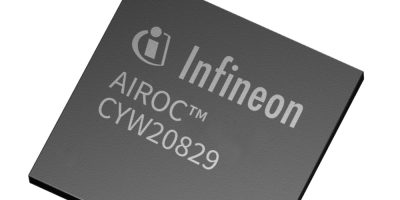The newly release Bluetooth 5.4 specification is integrated in Infineon’s Airoc CYW20829 Bluetooth LE SoC. According to Infineon, with the right combination of low power and high performance, Airoc CYW20829 is designed to support the entire spectrum of Bluetooth Low Energy (LE) use cases including smart home, sensors, medical healthcare, lighting, Bluetooth Mesh networks, remote controls, human interface devices (mouse, keyboard, VR and gaming controllers), industrial automation and automotive designs.
CYW20829 is a dual-core Arm M33 device where one M33 core is reserved as the Bluetooth controller, and the second Arm Cortex-M33 is available for customer applications. The CPU subsystem provides 256k RAM, XIP interface for external flash, and a rich set of peripherals including CAN. Built-in security features include secure boot, secure execution environment, a TRNG, eFuse for custom keys and cryptography acceleration.
The recently released Bluetooth Core Specification 5.4 adds several significant capabilities to the existing specification, including PAwR (periodic advertising with response), encrypted advertisement data (EAD) and Le GATT security levels characteristic. PAwR enables energy-efficient, bi-directional communication in a large scale one-to-many or star topology. EAD provides a standardised approach to the secure broadcasting of data in advertising packets, advised Infineon.
With PAwR, thousands of Bluetooth 5.4-enabled electronic shelf labels (ESL) and sensors will have bidirectional communication with a single access point. Messages can contain commands, sensor data values or other data, as defined by the application layer. EAD enables the encrypted data over-the-star network to be authenticated and decrypted only by devices that have shared the session key previously. Additionally, LeGATT security levels characteristic enables devices to identify the security mode and level for GATT functionality. The combination of these features enable low power, efficient radio usage and secure star networks that can be deployed in large scale ESL and sensor applications.
“With Infineon’s AIROC CYW20829 Bluetooth LE SoC, our customers can achieve great RF performance, the latest Bluetooth features, built-in security, rich set of peripherals, and low power, all in one device,” said Shantanu Bhalerao, Vice President of the Bluetooth product line at Infineon.
Airoc CYW20829 has best-in-class RF link budget, claimed Infineon, with an integrated power amplifier providing 10dBm of transmit output power and receive sensitivity of -98dBm for LE 1Mbits per second and -106dBm for LE Long Range 125kbits per second.
The Airoc CYW20829 is supported by the ModusToolbox development environment which enables developers to accelerate time-to-market for Bluetooth-enabled IoT solutions.
The SoC is currently sampling to select customers.






